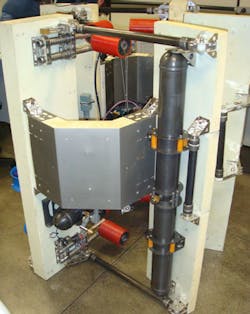Autonomous Vehicle to Simplify Underwater Inspection for Petrobras
More than 600 participants came to National Instruments’ NI Days 2010 in Brazil on March 23. One of the highlights of the various user presentations was the presentation of Ricardo Artigas Langer, control and automation engineering software manager from Engemovi (www.engemovi.com.br), a company created to provide high-level solutions in industrial automation. In 2007, the company developed, the first inertial PIG (Pipeline Inspection Gauge) in Brazil.
According to Langer, oil extraction from the ocean floor with floating platforms requires flexible pipes, called risers. Such pipelines require periodic visual inspection that is currently performed with a Remotely Operated Underwater Vehicle, which requires an elaborate infrastructure and, in fact, demands expensive operations.
“An innovative concept of an autonomous vehicle was proposed by the Petrobras production team to collect images from risers, which will make the inspection of these structures easier. The vehicle has a ‘necklace’ form whose moves are guided by the riser where it is installed. This vehicle allows riser inspection with sensors that were not feasible before, such as ultrasonic sensors and gammagraphy,” said the manager. Petrobras is the Brazilian government-owned energy company.
The AURI (Autonomous Underwater Riser Inspector) project coordination was done by Cenpes (Petrobras Research Center), while CPIT (Centro de Pesquisa em Tecnologia de Inspeção, or Research Center in Inspection Technology)—a partnership between Catholic University of Rio de Janeiro and Petrobras—had the responsibility for the technology during the testing phase and transfer to industry. Engemovi was hired to conduct the project and its team worked with the Cenpes and CPTI engineers during the whole process. The company had the task of embodying in a prototype the concept developed by the Cenpes’ engineers.
Managers for the AURI project chose the Compact Vision System (NI-CVS) from National Instruments Brazil (NI, www.ni.com/brasil), which serves as on-board computer, controlling the propellers and all of their sensors, including the illumination and the images acquisition.
Langer said that the team could have used other available technology in the market, but explained that none of it has the size, the robustness, the interfaces and the programming ease found in NI’s LabView environment. “In the future, at the product design stage, CVS can be replaced by cheaper hardware. However, during the development, it is interesting to use a powerful tool available in the market to facilitate the engineering work,” he concluded.
About the author
About the Author

Leaders relevant to this article:
